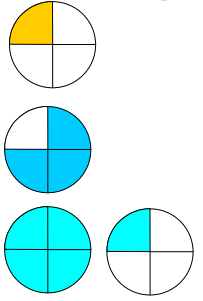Folding rectangles, squares and circles
This task is about folding shapes to show fractions.
|
a)
|
i)
ii) |
Fold the rectangle to show halves. Show someone and tell them how you know it's halves.
Draw and shade what one-quarter of the rectangle looks like. |
|
|
|||
|
b) |
i) |
Fold the square to show thirds. Show someone and tell them how you know it's thirds. |
|||||||
|
|||||||||
|
c) |
i) |
Fold the circle to show quarters. Show someone and tell them how you know it's quarters. |
||||||
|
||||||||





 ask them how they know that the parts are equal.
ask them how they know that the parts are equal.